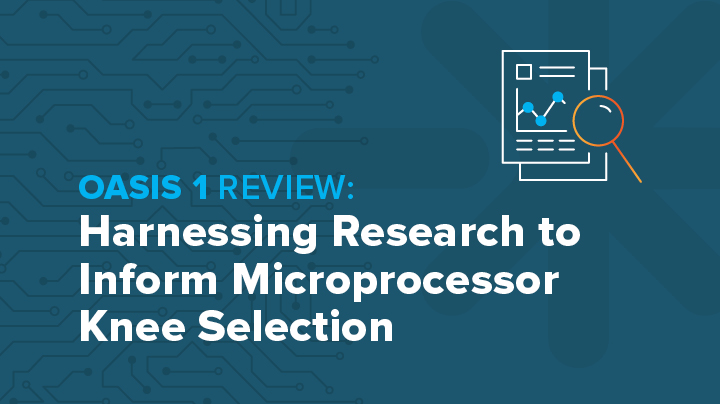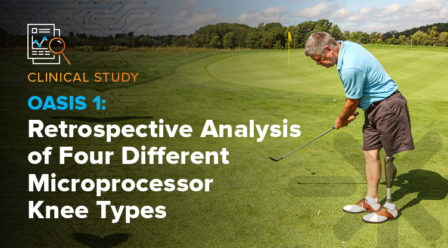OASIS 1 Review: Harnessing Research to Inform Microprocessor Knee Selection

A retrospective analysis of clinical outcomes associated with microprocessor knees was recently published in the Journal of Rehabilitation and Assistive Technologies Engineering (RATE). The analysis, known as OASIS 1, compared four commonly-prescribed microprocessor knee models in the following domains: mobility, quality of life, satisfaction with amputee status, and injurious falls. It is the first to objectively measure differences across various manufacturers’ devices, not just device categories, and carries the advantage of being completed and disseminated, absent of potential bias due to manufacturer funding or publication. Here is a summary of the results along with insights from the researchers themselves on how to leverage the findings to support clinical decision-making.
Three Facets of Evidence-Based Medicine
According to one of the OASIS 1 study authors Phil Stevens, MEd, CPO/FAAOP, there are three facets of evidence-based practice:
- Research
- Clinical experience
- Patient values and preferences
Each facet is equally important and each works concurrently with the others to enhance patient outcomes. It is important to keep this in mind when integrating different componentry into care plans for your patients, and it’s something to consider as new products are introduced which may or may not lend themselves to alternative care plans.
The Genesis of OASIS 1
Analyses like OASIS 1: Retrospective analysis of four different microprocessor knee types are a critical component to the first facet of evidence-based medicine as noted above. While microprocessor knees (MPKs) are among the most studied components in prosthetic rehabilitation, the initial data available was not robust enough to provide prescription guidance for the differing device options. To a great extent, the guidelines we’ve come to associate with MPKs came from studies of the Ottobock C-Leg while evidence relating to other MPKs was more limited.
We know that all MPKs are different – their mechanisms are different, the sensors they utilize are different, the actuators that respond to those sensors are different, and the logic that drives the microprocessors are different. This creates questions as to how well different knees might provide the benefits associated with MPKs in the literature. Trying to find an answer to these questions is the genesis of OASIS 1.
OASIS 1 Results
Conducted by Hanger Clinic researchers Jim Campbell, PhD, Phil Stevens, MEd, CPO/FAAOP, and Shane Wurdeman, PhD, CP, FAAOP (D), the OASIS 1 retrospective analysis looked at outcomes in the areas of mobility, satisfaction, quality of life and injurious falls were examined for patients using: Blatchford’s Orion, Freedom Innovations’ Plié, Ossur’s Rheo, and Ottobock’s C-Leg.
Results found there was a degree of parity among the four different MPK models for the sample of 602 individuals, with no differences reported in mobility or satisfaction. Patient demographics were overall very similar, with some subtle differences. C-Leg users were generally older (median age 61), Plié users comprised the highest percentage of females (31.46%), and Rheo users comprised the highest percentage of employed individuals (32.35%).
While there were no significant differences in mobility and satisfaction between the four models, researchers did see a significant reduction in injurious fall rates for C-Leg and Orion users compared to injurious fall rates for patients with amputation due to diabetes or vascular disease using a non-microprocessor knee. Additionally, the study reported similar age-related changes in outcomes with each MPK.
See Full Study Details
Review the OASIS 1 study design and results in more detail, and download the full publication.

Implications for Clinical Practice
When considering various MPK types for your patients, this analysis tells us the choice should be based on the end goal. If your goal is to increase mobility, satisfaction, and/or quality of life, then the data supports any of the four MPKs that were evaluated. However, if your goal is to reduce the risk of falls, then this research demonstrated the lowest percentage of injurious falls with C-Leg and Orion users.
All this being said, we know that evidence-based medicine should not solely rely on what the research shows. It is an important facet, but the other two – clinical experience and patient values/preferences – should also be taken into account.
OASIS 1 is the first in a planned series of analyses evaluating the association between clinical outcomes and various prosthetic components. The Hanger Clinic Department of Clinical and Scientific Affairs is working on other constructs comparing the effectiveness of a variety of orthotic and prosthetic components across different patient groups that can be used to help clinicians make unbiased decisions related to product selection and utilization.
Want to Learn More About OASIS 1? Watch Our Recorded Webinar and Earn CEUs.
On-Demand Credit Available for O&P Professionals
Watch the recording, then submit your credit request.
Driven by Evidence, We Empower Human Potential.
The goal of Hanger Clinic’s Department of Clinical and Scientific Affairs is to explore, expand, and facilitate opportunities that advance the science and care in O&P.
Latest Updates
Subscribe to stay up-to-date on our latest posts.


